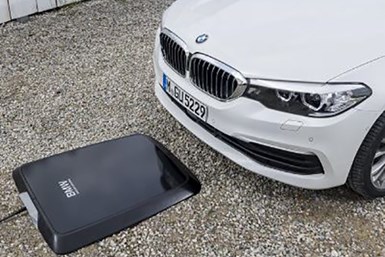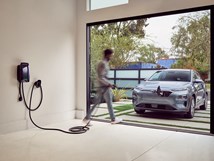WiTricity Lands New Funding
Wireless charging developer targets mainstream applications
#hybrid
Boston-based WiTricity has big plans for its wireless charging technology as demand for electric vehicles begins to accelerate, especially in Europe and Asia.

Wireless charging pad (Image: BMW)
In the last 20 months, the company acquired one of its main rivals—Qualcomm’s Halo business—and launched its first two production applications in the high-end BMW 530e iPerformance sedan and McLaren Speedtail Hyper-GT supercar.
Now WiTricity is taking aim at more mainstream models.
Partnering Up
To support the effort, WiTricity has raised an additional $34 million in funding.
WiTricity plans to use the capital infusion on r&d, expanding its intellectual property portfolio—with the Halo purchase it has more than 1,000 global patents—and commercialization programs.

(Image: WiTricity)
Among the new investors are Mitsubishi Corp.’s Americas operations, Stage 1 Ventures and Air Waves Wireless Electricity. Mitsubishi says its Urban Development Group (UDG) will work with WiTricity on programs for electric and autonomous vehicles in smart cities. Mitsubishi Motors currently offers the Outlander plug-in hybrid in the U.S.
“WiTricity's wireless charging is essential for next-generation infrastructure services that capture the shift to EV and autonomous driving,” says UDG CEO Mitsumasa Icho. “We intend to capitalize on wireless charging, IoT, AI, robots and big data in smart cities.”
Setting Standards
WiTricity also stands to benefit from SAE International’s new J2954 wireless charging standard that was finalized last month.
The protocol, which has been in the works for 13 years, will enable EVs and plug-in hybrid models across most manufacturers to use a common wireless system. J2954 sets criteria for interoperability, electromagnetic compatibility, EMF performance and safety for wireless equipment for EVs and ground-system equipment.
The supplier also is working with the International Organization for Standards and various groups in China and Europe.
How It Works
WiTricity’s system uses an induction pad that generates a magnetic field to transfer electricity to a vehicle-mounted receiver.
Charging is automatically initiated when an EV or plug-in hybrid is parked, and the receiver is within 10 inches of the pad. Only one vehicle can be charged at a time.
The system supports Level 1 or Level 2 systems. Charging speeds are equivalent to plug-in conductive units and have a grid-to-vehicle efficiency rate of more than 90%, according to the supplier.
What’s Next
“The expanding EV market is now ready, industry standards are set and we’re excited to bring the wireless charging experience to customers,” says WiTricity CEO Alex Gruzen.
In addition to BMW, McLaren and Mitsubishi, WiTricity is working with several other carmakers and suppliers. The company says it has licensing agreements with about a dozen companies, including Aptiv, Mahle and Toyota.
WiTricity also expects wireless charging to be a key enabling technology for future robo-taxis and other shared cars. These vehicles often are driven around the clock, the supplier notes, thus need easier and faster charging capabilities to stay on the road longer.
RELATED CONTENT
-
on lots of electric trucks. . .Grand Highlander. . .atomically analyzing additive. . .geometric designs. . .Dodge Hornet. . .
EVs slowdown. . .Ram’s latest in electricity. . .the Grand Highlander is. . .additive at the atomic level. . .advanced—and retro—designs. . .the Dodge Hornet. . .Rimac in reverse. . .
-
On Fuel Cells, Battery Enclosures, and Lucid Air
A skateboard for fuel cells, building a better battery enclosure, what ADAS does, a big engine for boats, the curious case of lean production, what drivers think, and why Lucid is remarkable
-
Jeeps Modified for Moab
On Easter morning in Moab, Utah, when the population of that exceedingly-hard-to-get-to town in one of the most beautiful settings on Earth has more than doubled, some people won’t be hunting for Easter eggs, but will be trying to get a good look at one of the vehicles six that Jeep has prepared for real-life, fast-feedback from the assembled at the annual Easter Jeep Safari.








